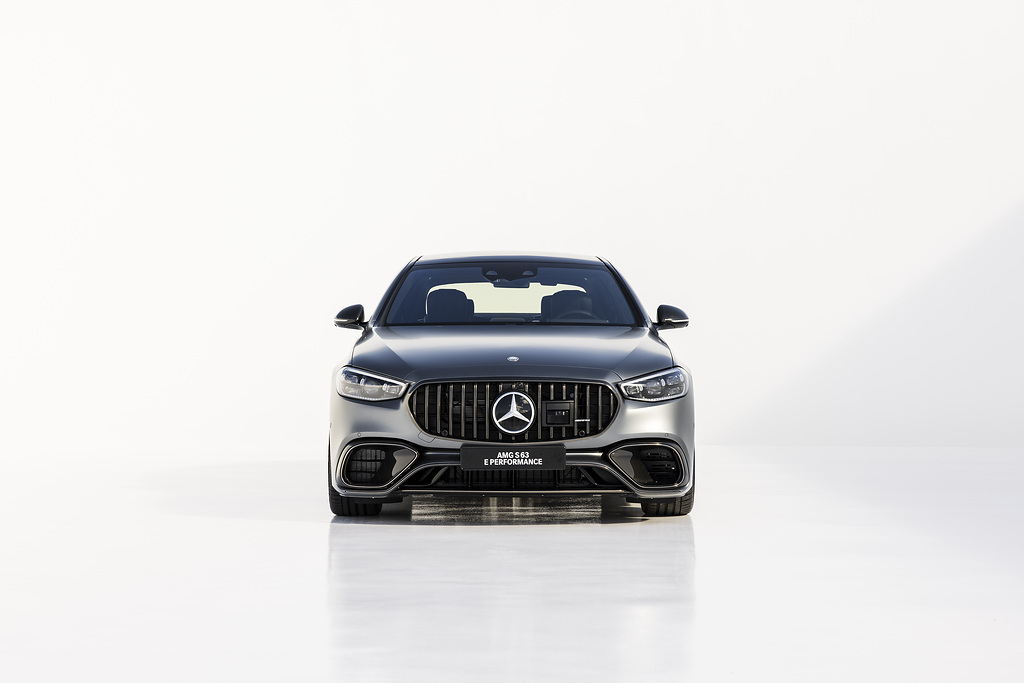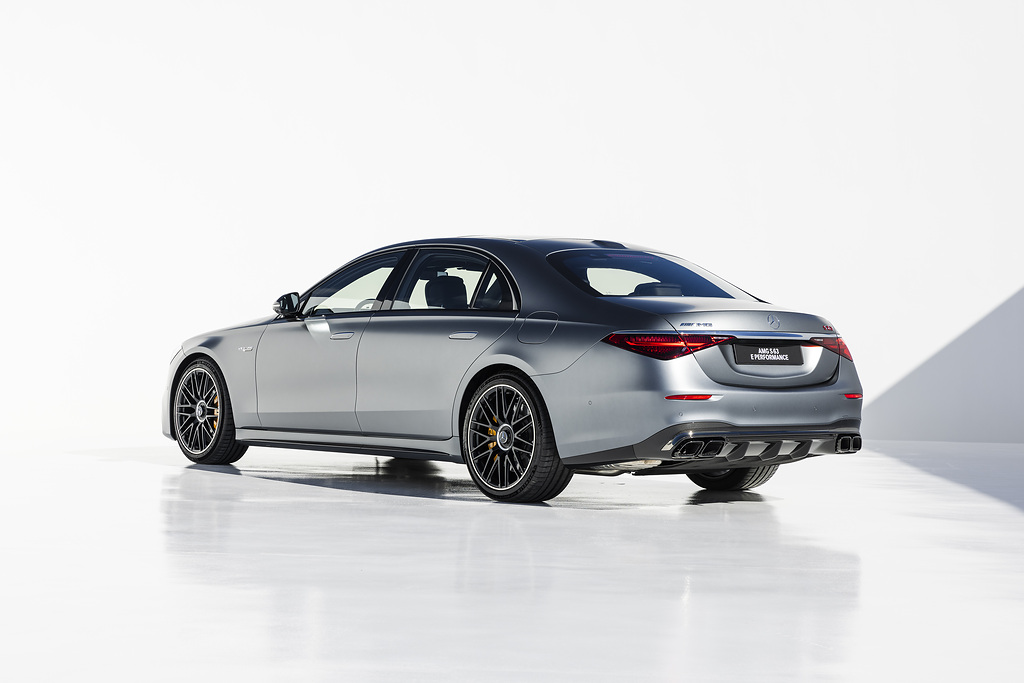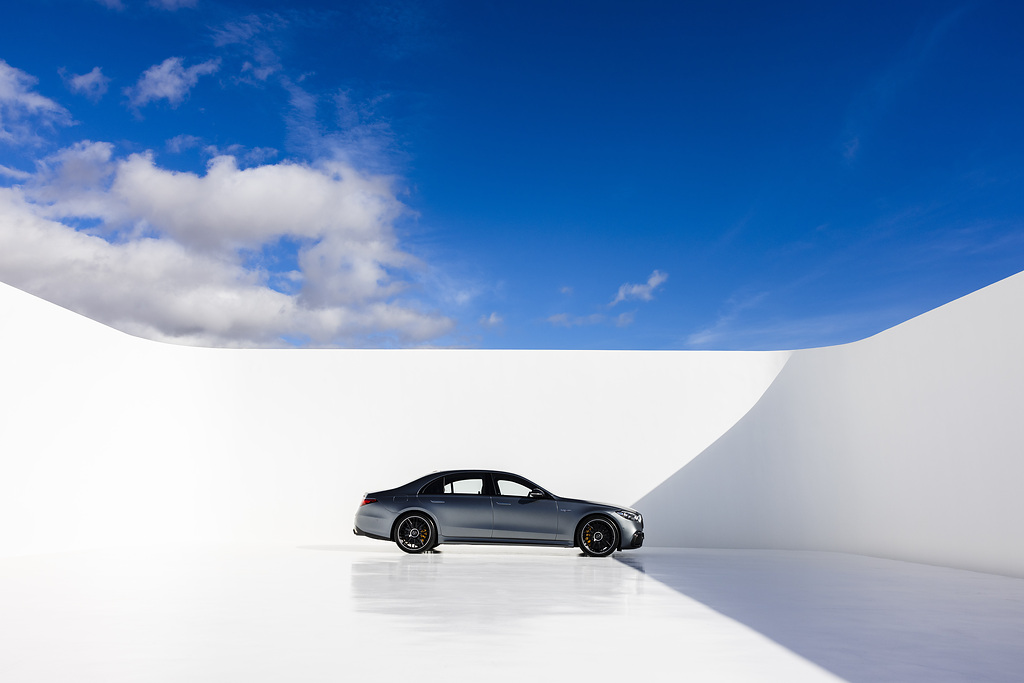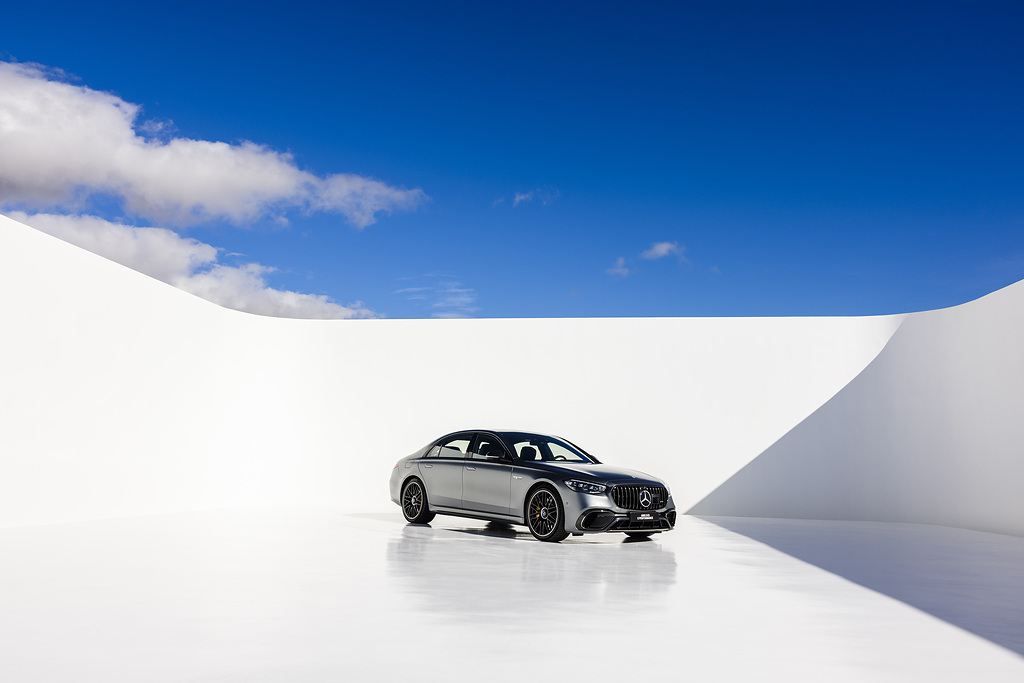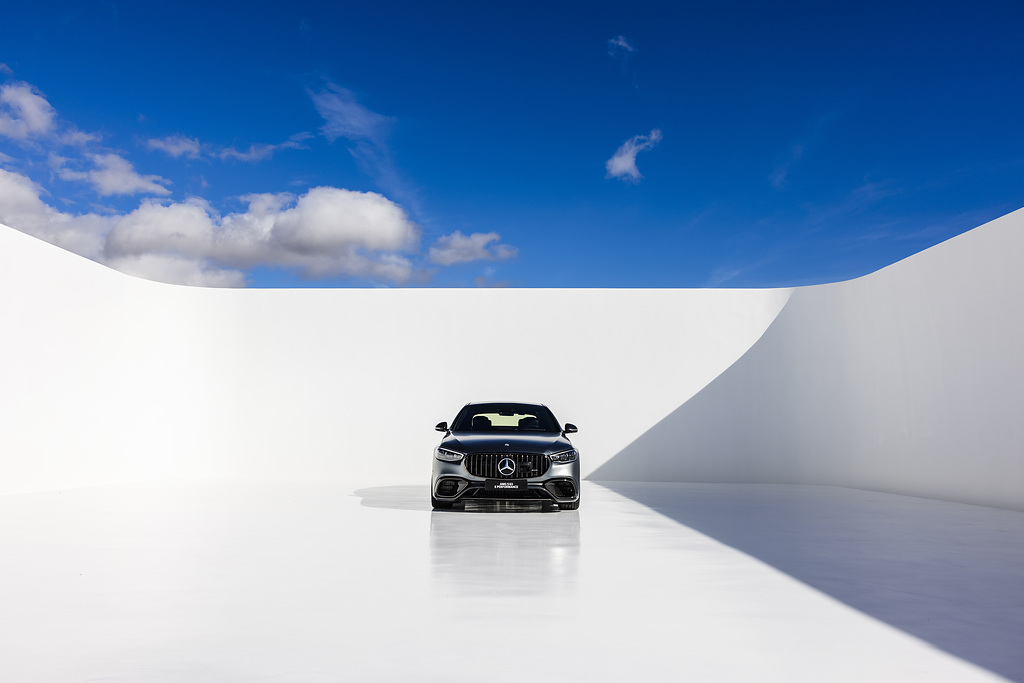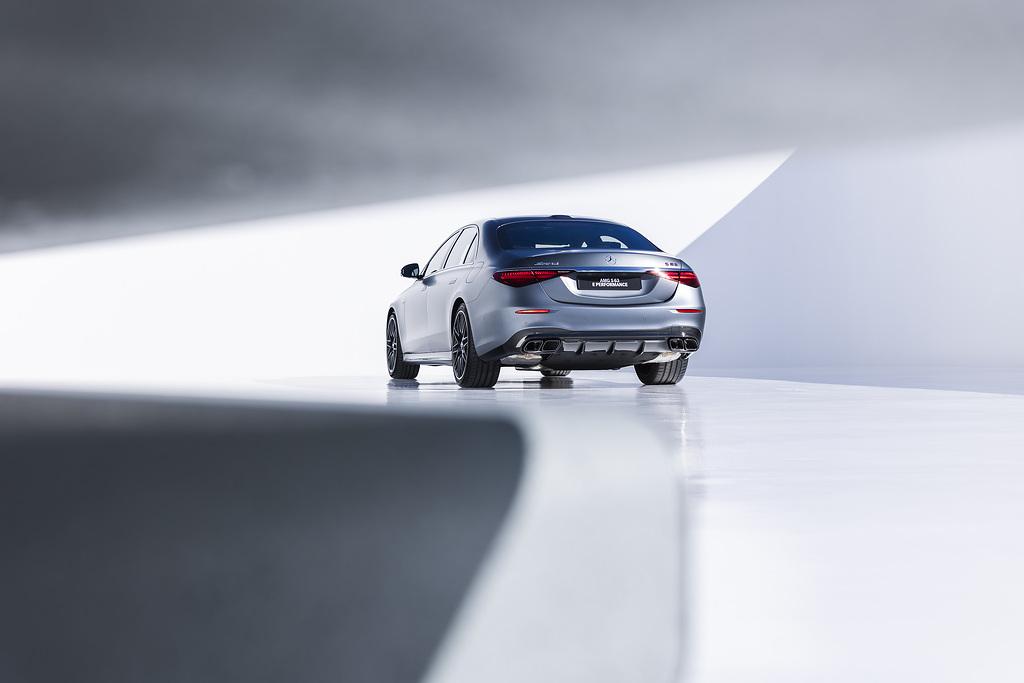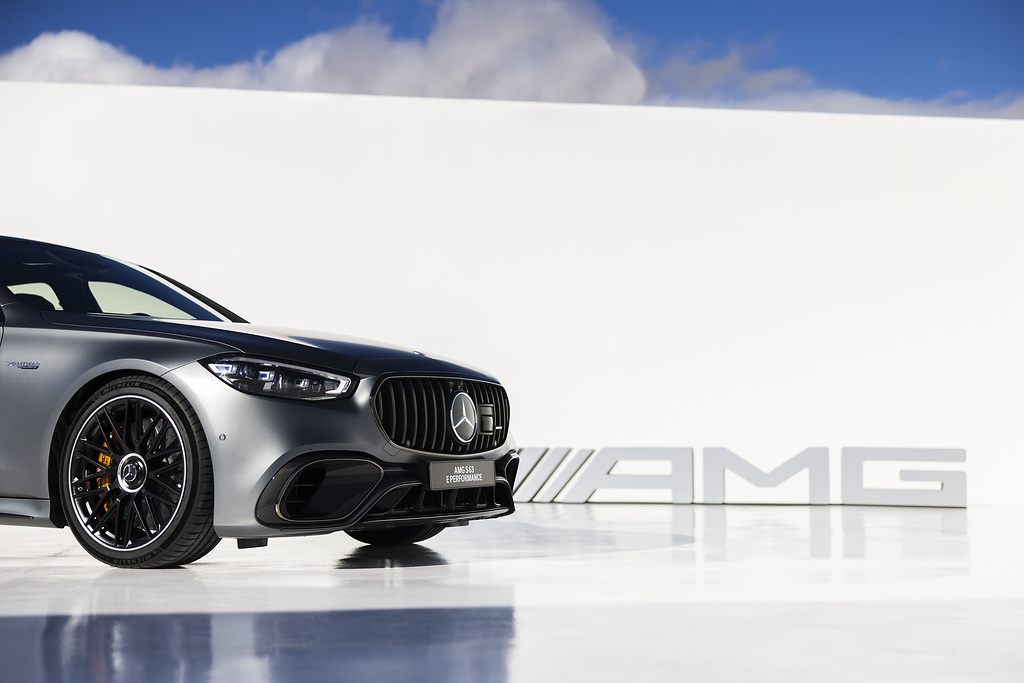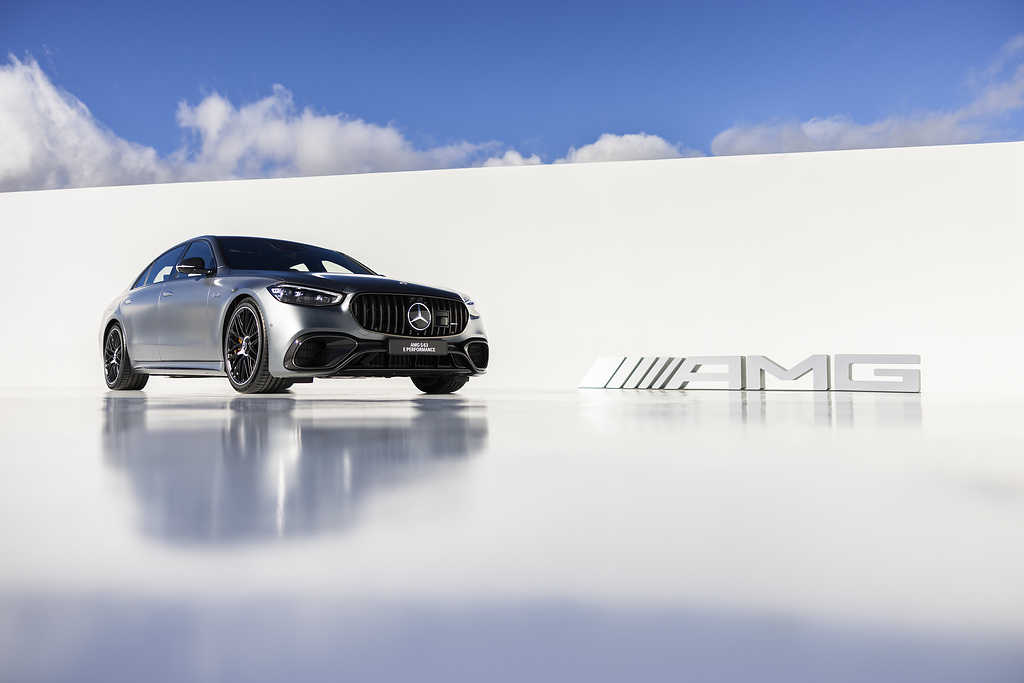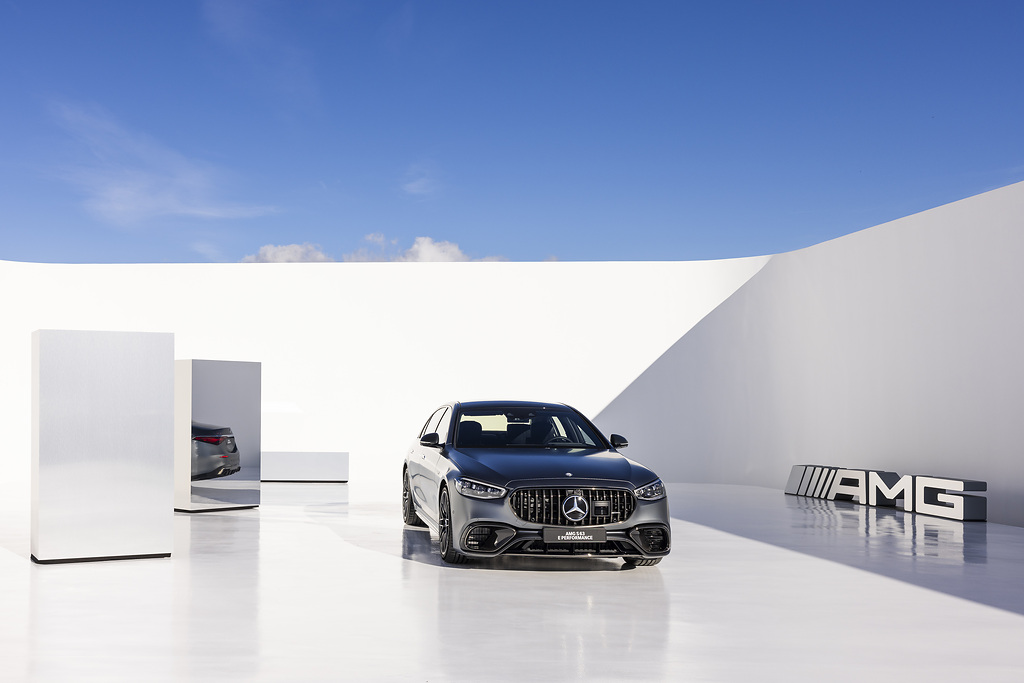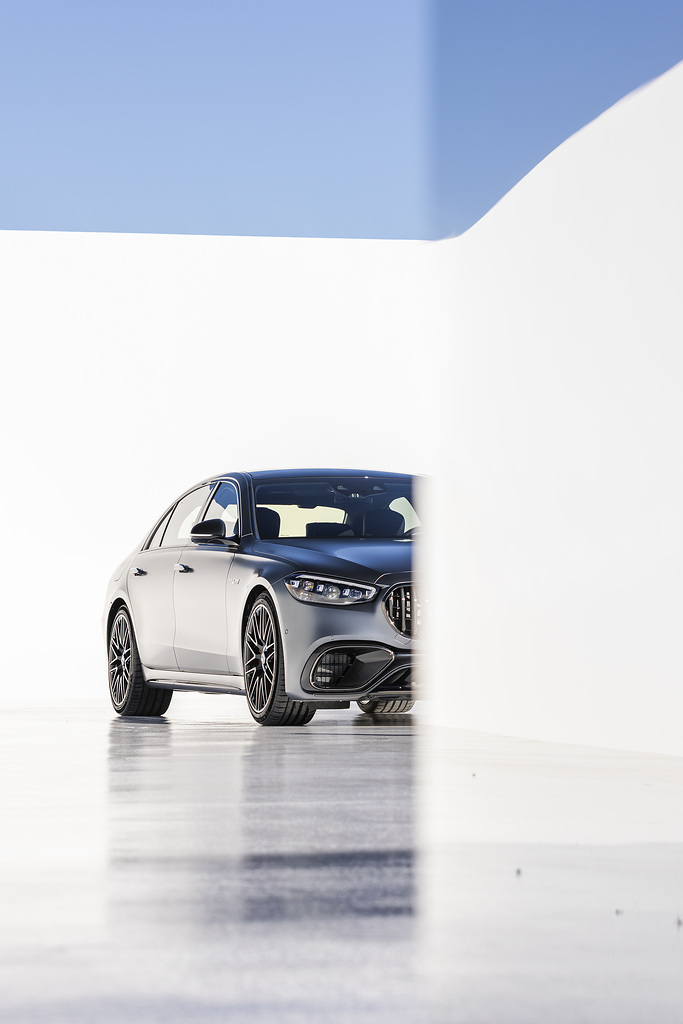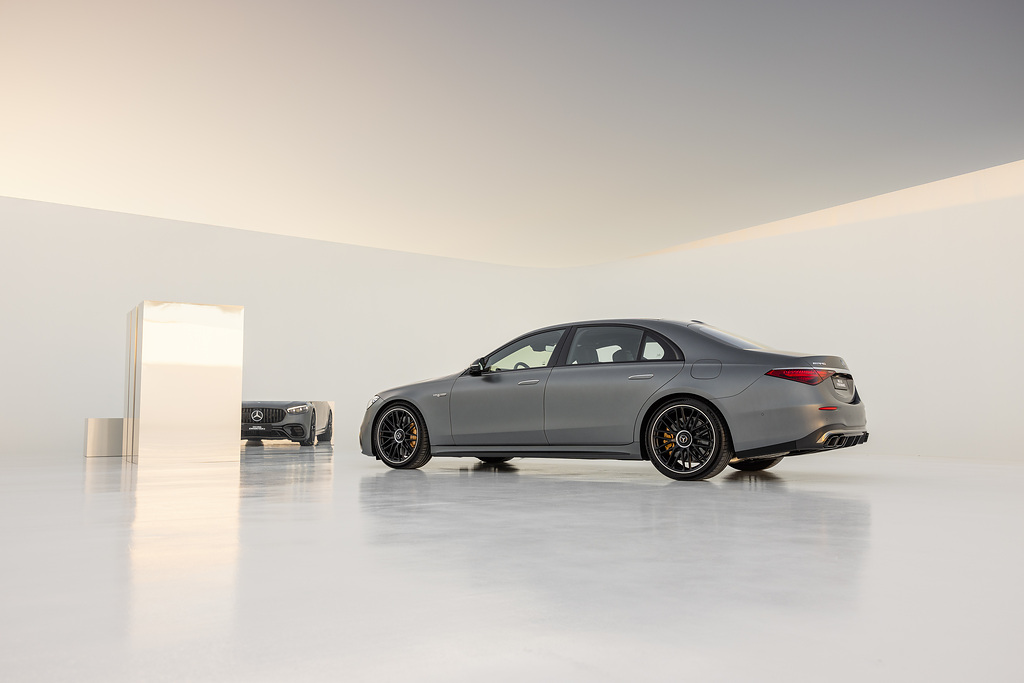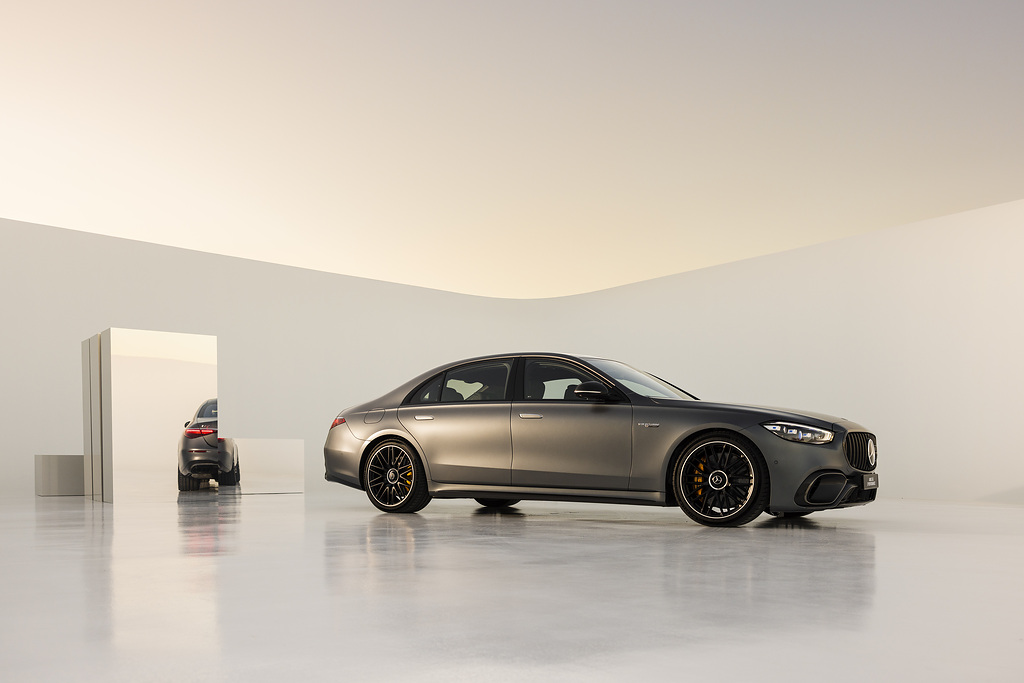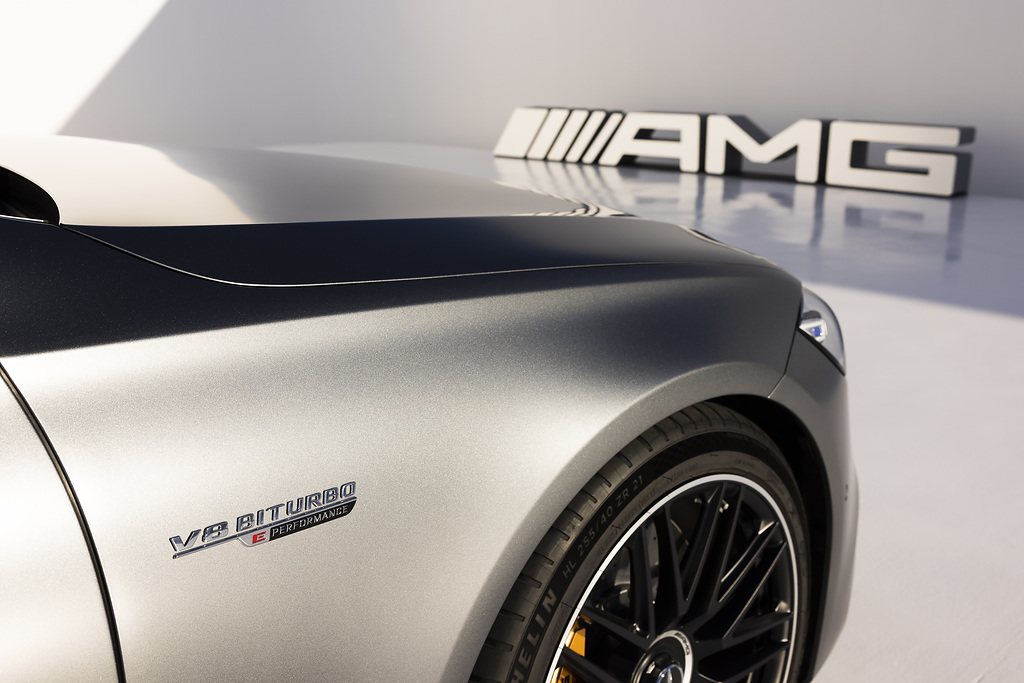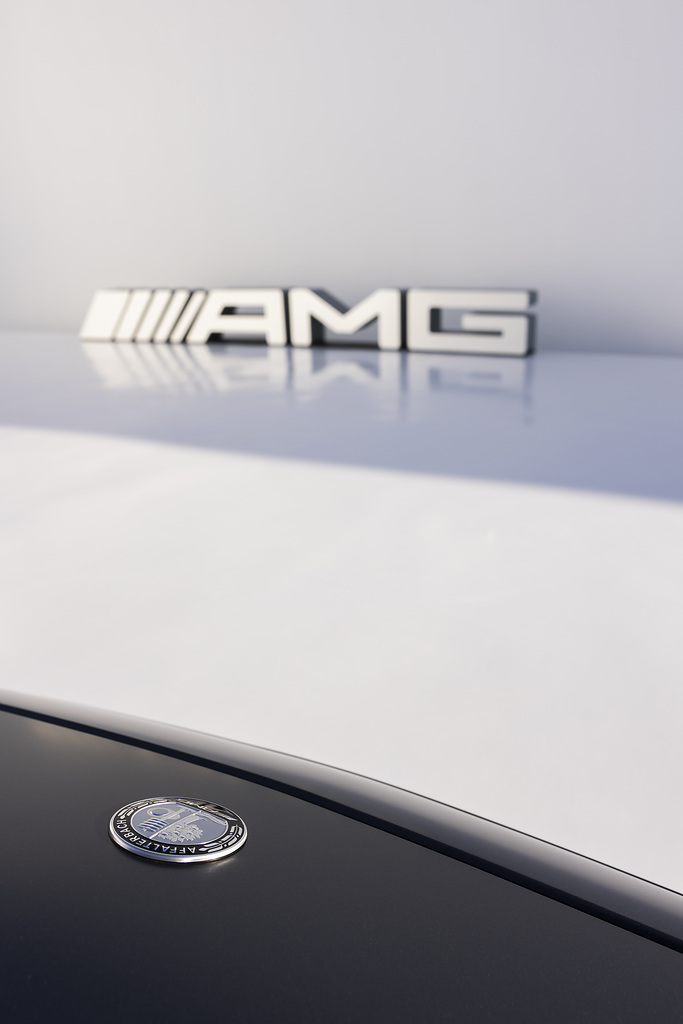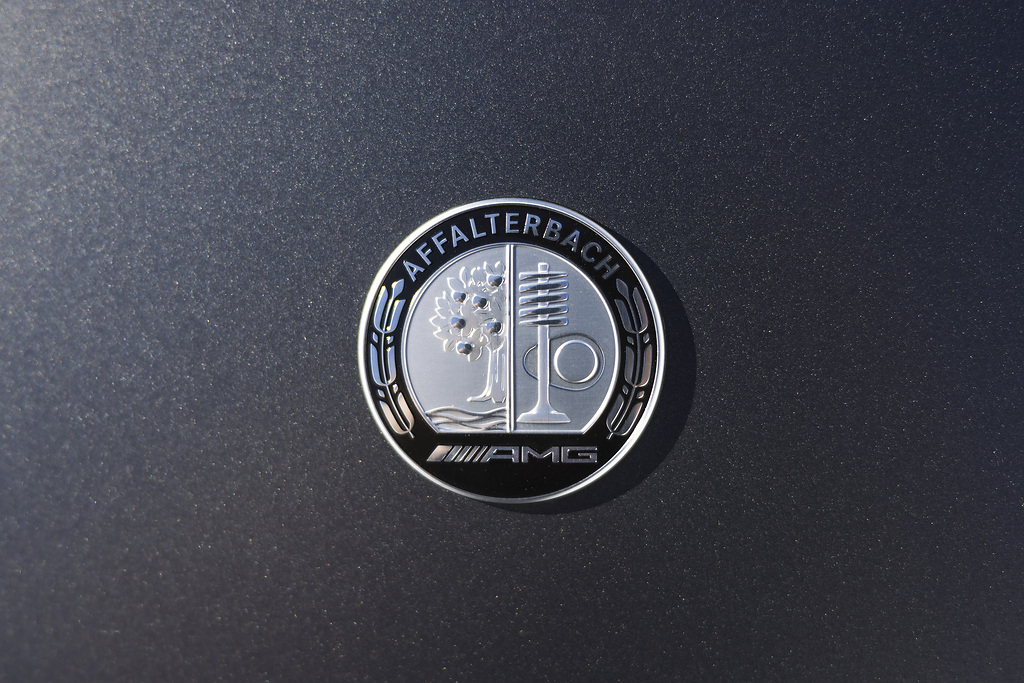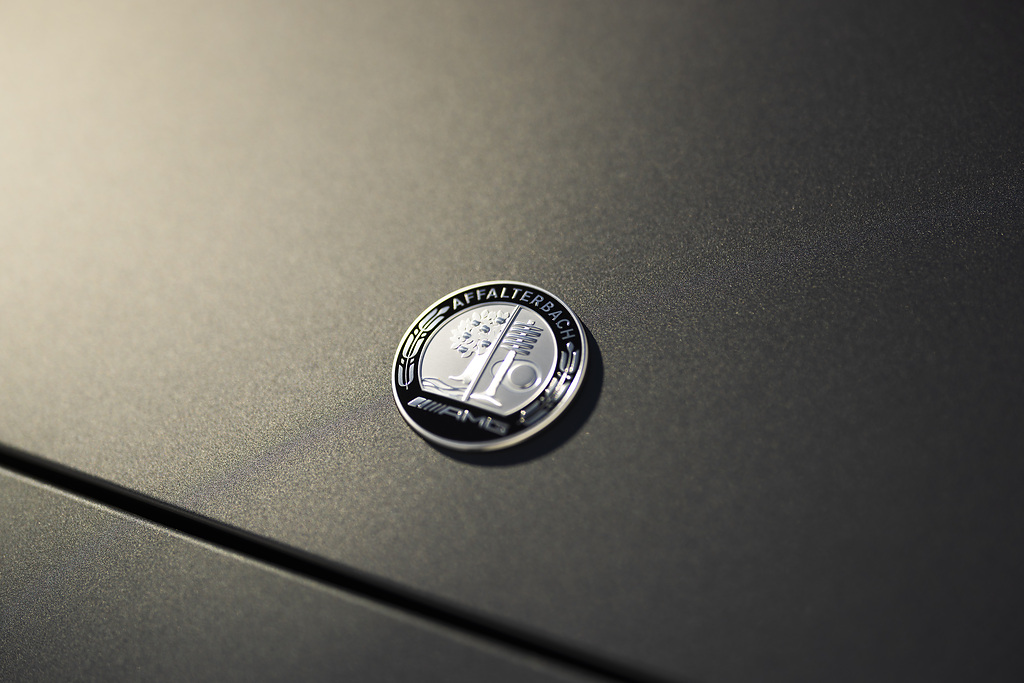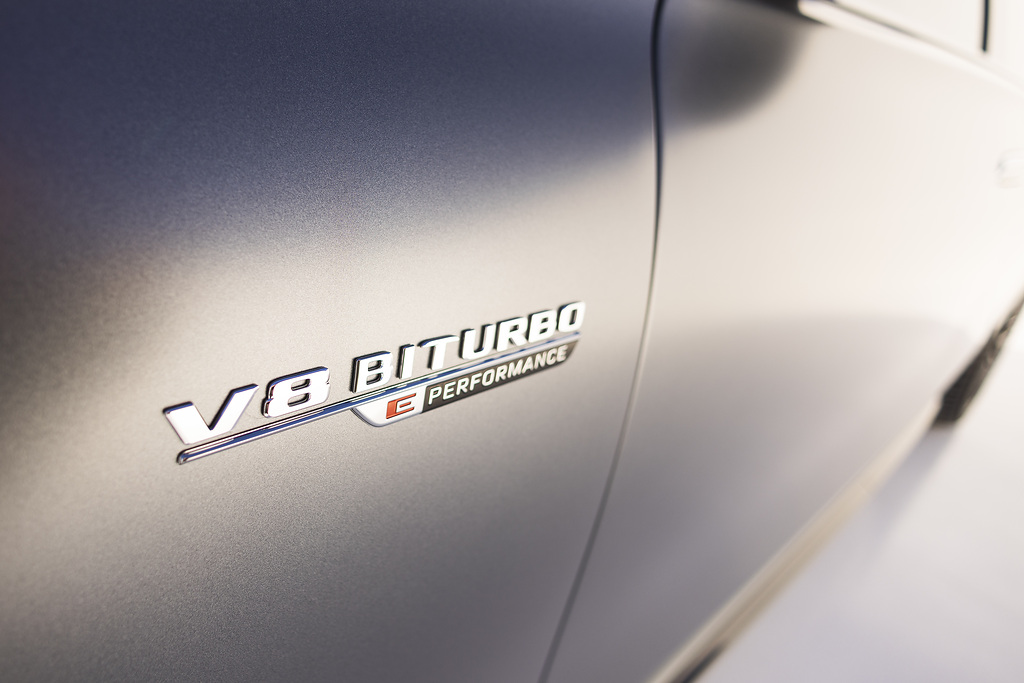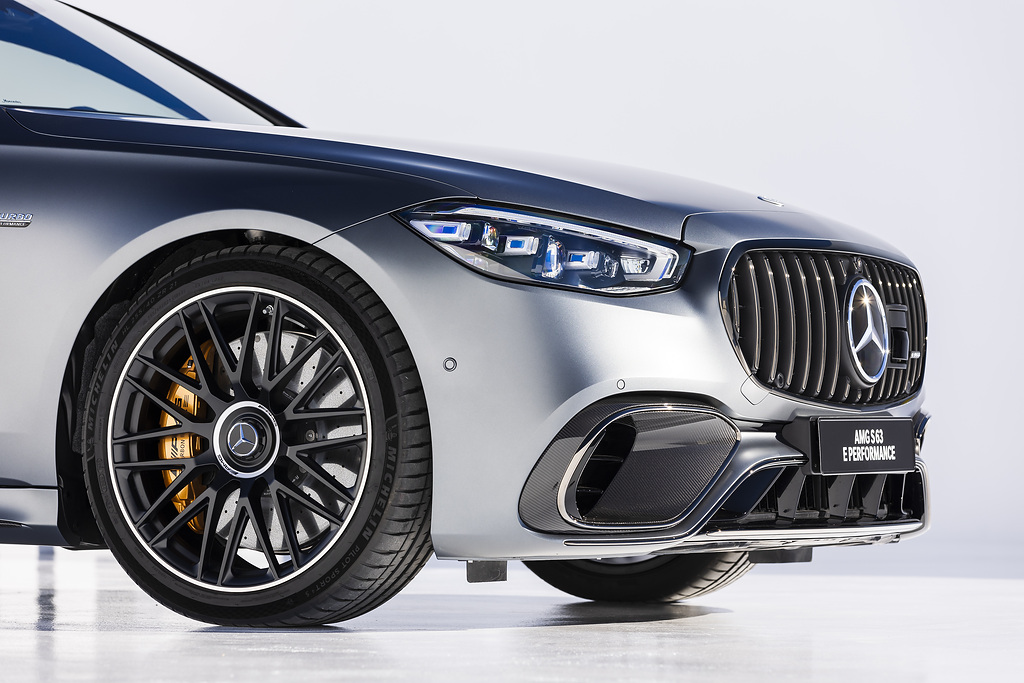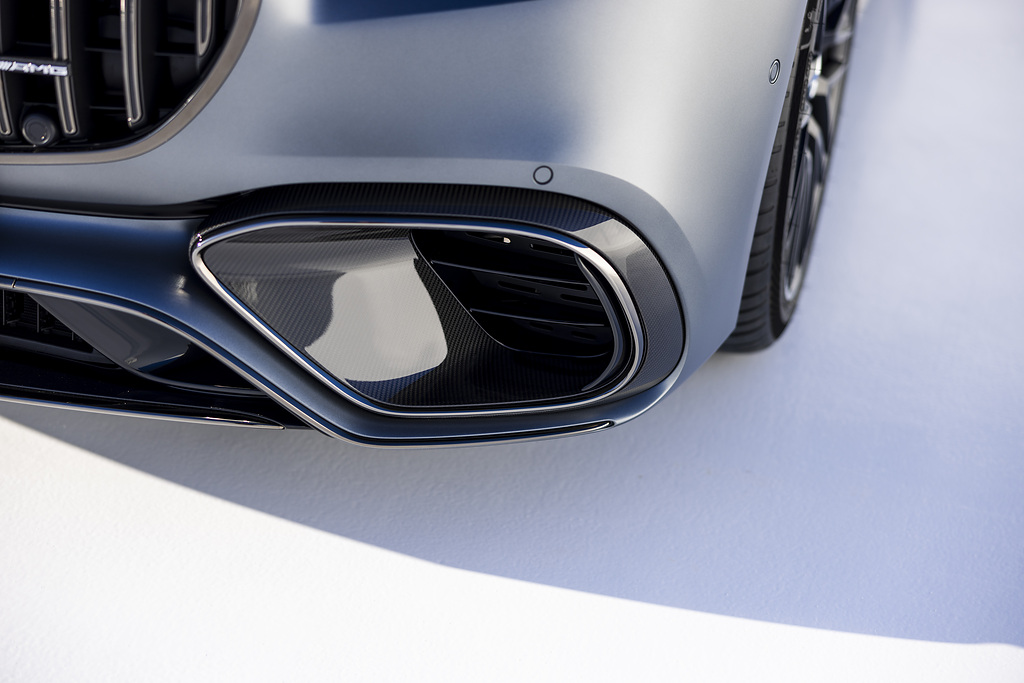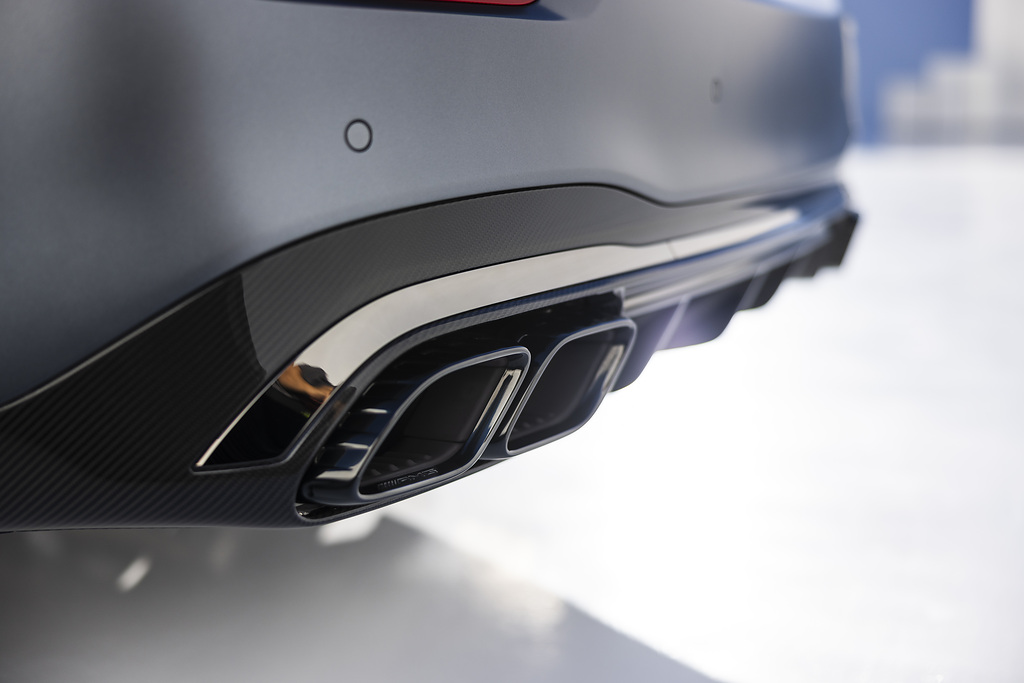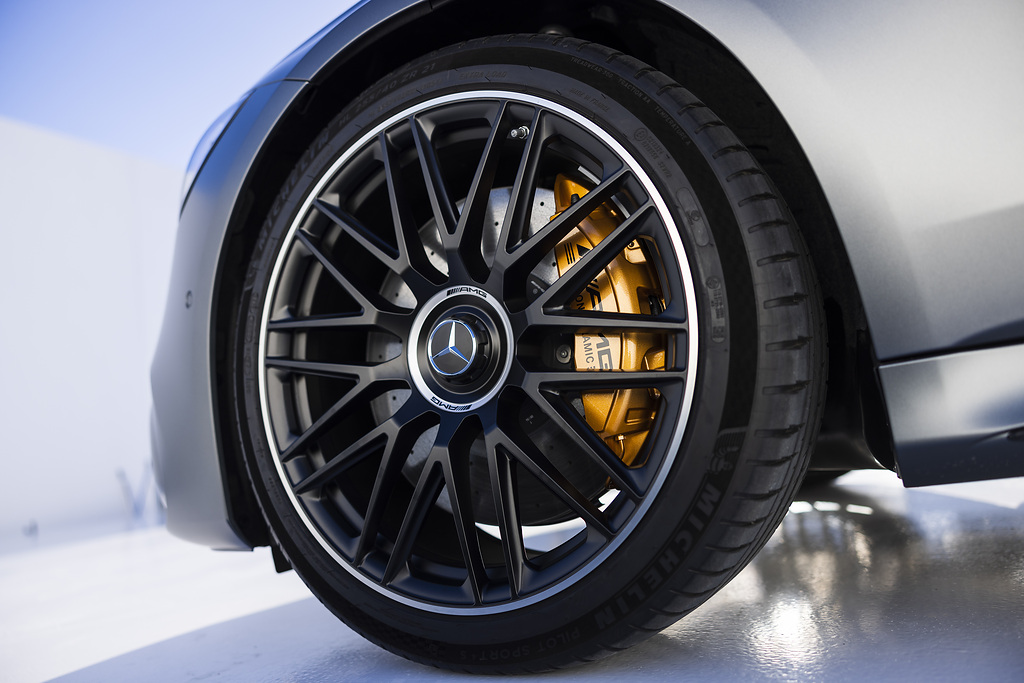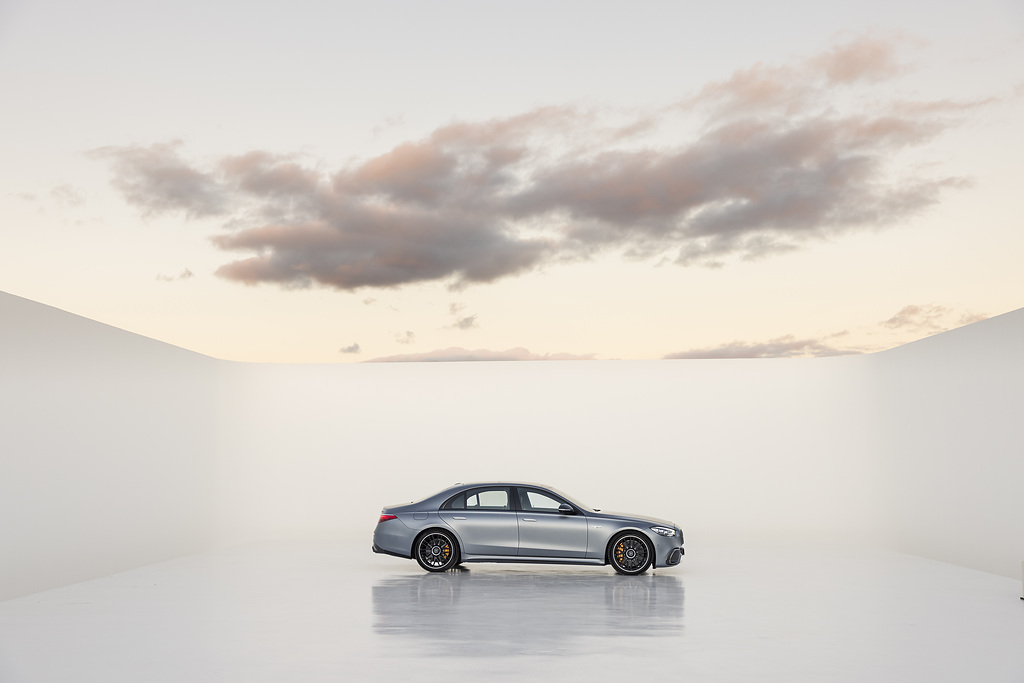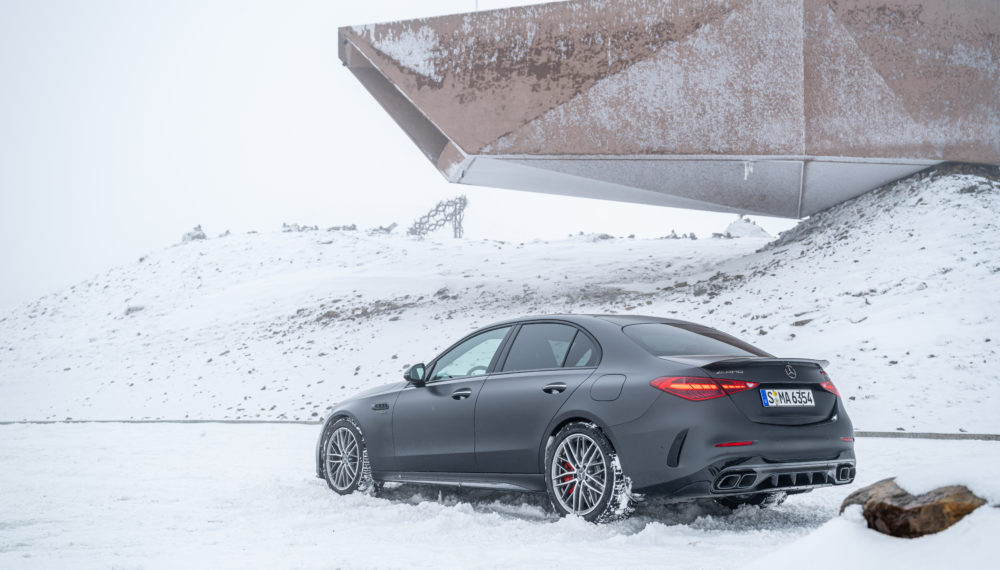The AMG-specific E PERFORMANCE hybrid drive: combustion engine in the front, electric motor in the rear
In the new Mercedes-AMG S 63 E PERFORMANCE, the 4.0-litre V8 biturbo engine is combined with a permanently excited synchronous electric motor, a high-performance battery developed in Affalterbach and the fully variable AMG Performance 4MATIC+ all-wheel drive system. The system output of 590 kW (802 hp) and the maximum system torque of 1430 Nm make for impressive driving performance: Acceleration from standstill to 100 km/h takes just 3.3 seconds. Power delivery only ends at an electronically governed 290 km/h (with the optional AMG Driver’s Package).
The 140 kW (190 hp) electric motor is positioned at the rear axle, where it is integrated with an electrically shifted two-speed transmission and the electronically controlled limited-slip rear differential to form a compact electric drive unit (EDU). Experts refer to this layout as a P3 hybrid. The high-performance battery is also located in the rear above the rear axle.
The decisive advantage of this EDU position is bypassing of the 9-speed transmission, which is flanged to the V8 engine. As it is positioned behind the transmission, the torque of both drive units can be fully utilised. The result: 1430 Nm of system torque – a new record in this class. And there are many more arguments in favour of the P3 setup as a performance hybrid:
- The P3 concept makes it possible to boost electrically at full torque across the entire rpm range.
- The electric motor acts directly on the rear axle, and can therefore convert its power more directly into propulsion – for that extra boost when moving off, accelerating or overtaking.
- The inherent design of the electric motor means that its power can kick in straight away at full torque, making particularly agile starting possible.
- In addition, the driver immediately experiences a noticeable performance increase thanks to the integrated, electronically controlled limited-slip rear differential: the hybrid model accelerates out of bends with great agility.
- In the event of slip at the rear axle, the drive power from the combustion engine and electric motor is also transferred to the front wheels as required. This is made possible by mechanical connection of the fully variable all-wheel drive by means of the propshaft and drive shafts of the front wheels. It also makes it feasible to drive purely electrically with all-wheel drive.
- The positioning at the rear axle improves the weight and axle load distribution in the vehicle. This forms the basis for the compelling handling.
- The AMG concept offers very high recuperation efficiency, as the system allows only minimal mechanical and hydraulic losses from the engine and transmission. In the “Comfort” driving mode, the combustion engine can be specifically disconnected. This reduces drag torque when the driving situation permits.
- The two-speed transmission at the rear axle shifts automatically. With its specially tuned gear ratio, it ensures a combination of high wheel torque for agile starting and smooth, continuous performance at higher speeds. An electric actuator engages second gear at around 140 km/h at the latest, which corresponds to the electric motor’s maximum speed of around 13,500 rpm.
- With the increase in performance due to the additional electric motor, the development team was also able to improve the efficiency of the entire vehicle in parallel – and achieve lower emissions as well as lower consumption.

Mercedes-AMG S 63 E PERFORMANCEq
Permanently excited synchronous motor (PSM)
The PSM is equipped with a hollow rotor made of permanent magnets and can thus be installed around the output shaft to the left rear wheel. The electric motor is controlled by power electronics, which are likewise located at the EDU and convert accelerator pedal commands directly to suitably actuate the PSM. In addition, the sensitive control of the electric motor adjusts the speed during gearshifts by the two-speed transmission. This means that the transmission in the EDU does not require any mechanical synchronisation at all. The boost torque of the electric motor can thus also be used at higher speeds. The maximum torque of an electric motor is available from the first revolution, but drops again later at higher rpm. Therefore the second gear, which is engaged at higher speeds, brings the electric motor into a range with lower rpm, so that it can support the combustion engine over the entire speed range.
Inspired by Formula 1™, developed in Affalterbach: the AMG high-performance battery
When the electrification strategy was being defined, it was clear from the outset that all essential components would be developed in Affalterbach. Among these is the AMG high-performance battery (HPB). The development of the lithium-ion energy storage system is inspired by technologies that have proven themselves in the Mercedes-AMG Petronas F1 Team’s Formula 1 hybrid racing cars. The team of experts from the Formula 1 engine manufacturer High Performance Powertrains (HPP) in Brixworth collaborated closely with Mercedes-AMG in Affalterbach. The AMG high-performance battery combines high power that can be called up in rapid succession with low weight to enhance the overall performance of the vehicle. Added to this are the fast energy draw and the high power density.
80 kW continuous output and 140 kW peak output
The high-performance battery in the S 63 E PERFORMANCE has a capacity of 13.1 kWh, more than twice as much as the already familiar HPB 80. It delivers 80 kW of continuous mechanical power and 140 kW of peak mechanical power (for ten seconds) to the electric motor. External charging takes place via the 3.7 kW onboard AC charger, at a charging station, wallbox or household socket. The battery is designed for fast power delivery and draw, not for the longest possible range. Nevertheless, the electric range of 33 kilometres allows a practical operating radius, for example for quiet all-electric driving from a residential area.
The continual push for innovation: direct cooling of the battery cells
The basis for the high performance of the AMG 400-volt battery is direct cooling: A high-tech coolant based on an electrically non-conductive liquid flows around all 1200 cells and cools them individually. Every battery needs a defined temperature for optimum power delivery. If the energy storage unit gets too cold or too hot, it temporarily loses noticeable power or has to be turned down in order not to be damaged if the temperature level is too high. The consistent temperature of the battery therefore has a decisive influence on its performance, service life and safety. Conventional cooling systems, which use only air or cool the entire battery pack indirectly with water, quickly reach their limits If the thermal management does not fulfil its function optimally, the battery is at risk of ageing prematurely.
For direct cooling, the AMG team had to develop new cooling modules of millimetric thickness. Around 14 litres of coolant circulate from top to bottom through the entire battery, past each cell, with the help of a specially developed high-performance electric pump. In the process, the coolant also flows through an oil/water heat exchanger attached directly to the battery. This conducts the heat into one of the two low‑temperature circuits (LT) of the vehicle. From there, it goes on to the LT cooler at the front of the car, which releases the heat into the outside air. The system is designed to ensure even heat distribution in the battery.
The result is that the battery is always within a consistent, optimum operating temperature window averaging 45 degrees Celsius, no matter how often it is charged or discharged. It may well be that the average temperature is exceeded when driving at high speeds. The protection mechanisms are therefore set in such a way that the maximum power can be drawn from the battery in order to subsequently lower the temperature level again through direct cooling. Conventional cooling systems cannot cope with this, and the battery can no longer fully utilise its capacity. Not so the AMG High Performance Battery: Even under heavy load, where acceleration (battery is discharged) and deceleration (battery is charged) are frequent, the battery retains its high performance capacity.
Only effective direct cooling makes it possible to use cells with a very high power density. Thanks to this individual solution, the battery system is particularly light and compact. The material-saving conductor rail concept also contributes to the low weight. The light but at the same time robust crash structure of the aluminium housing ensures maximum safety.
Regeneration selectable in four stages
Because the high-performance battery is always in the optimum temperature window of around 45 degrees, recuperation can also be optimised: Normally, a battery heats up strongly at high regeneration capacity, so energy recovery must be limited.
Recuperation starts when the driver takes their foot off the accelerator pedal, i.e. in overrun mode without touching the brake pedal. This charges the battery and creates braking torque. This in turn saves strain on the wheel brakes: depending on the recuperation level and traffic situation, they do not have to be operated at all. Another advantage of regeneration: on steep descents, the system works like an engine brake and feeds energy into the battery. The driver can select four different levels of recuperation, using the right-hand AMG steering wheel button. With the exception of “Slippery”, this applies in all driving modes as well as in “ESP Sport Handling” or “ESP Off”, and the energy recovery is configured differently depending on the driving mode.
- Level 0: The vehicle behaves in a similar way to a conventional combustion engine with manual transmission, where the clutch is disengaged. If the driver lifts off the accelerator, the car coasts on with the least resistance. The recuperation level is very low, and serves only to maintain the vehicle’s power supply. With the combustion engine switched off, friction losses in the powertrain are reduced to a minimum.
- Level 1: This is the default setting. The regeneration is noticeable for the driver. It corresponds approximately to the deceleration of a conventional combustion engine with the clutch engaged.
- Level 2: Stronger regeneration. When going with the flow of traffic, the brake pedal hardly needs to be depressed.
- Level 3: Highest energy recovery. Here, almost so-called “one-pedal” driving is possible, just like in an all-electric car. Depending on the driving situation, over 90 kW of power can be fed back into the battery.
Operating strategy: electric power always available
The basic operating strategy is derived from the hybrid powerpack of the Mercedes-AMG Petronas Formula 1 racing car. As in the top class of motorsport, maximum propulsion is always available when the driver calls it up by kick-down – to accelerate powerfully out of corners or to overtake quickly. The electric power can always be called on and frequently reproduced via high recuperation performance and needs-based recharging. The car’s specific battery concept allows the optimal compromise between maximum driving dynamics and contemporary efficiency. All components are intelligently coordinated with each other: the performance gain can be experienced directly.
Seven AMG driving modes
The seven AMG DYNAMIC SELECT driving modes “Electric”, “Comfort”, “Battery Hold”, “Sport”, “Sport+”, “Slippery” and “Individual” are precisely tailored to the new drive technology. They thus offer a wide-ranging driving experience – from efficient to dynamic. The driving modes adjust important parameters: the response of the drive and transmission, the steering characteristic, the chassis damping or the sound. The boost power of the electric motor also depends on the respective driving mode. It can be selected via the display in the centre console or the AMG steering wheel buttons. However, one thing is the same in all modes: the peak power of the electric motor can be easily called up via the kick-down function. The haptic accelerator pedal provides a tangible pressure point that the driver’s foot must overcome.
As standard, the performance hybrid starts silently (“Silent Mode”) in the “Comfort” driving mode (USA: “Electric”) when the electric motor is switched on. In the instrument cluster, the “Ready” icon signals that the vehicle is ready to drive. In addition, a powerful, sonorous start-up sound characteristic of AMG is emitted in the interior via the vehicle’s loudspeakers as acoustic feedback showing readiness to get going. Slight pressure on the accelerator pedal is all it takes to set the AMG Performance hybrid in motion.
- “Electric”: the focus is on the electric driving experience. From standstill up to a maximum of 140 km/h, the vehicle drives purely electrically. The combustion engine always remains switched off. The mechanical connection to the AMG Performance 4MATIC+ components means that all-wheel drive is always available: if the rear wheels suddenly have too much slip, the power of the electric motor is also transmitted to the front wheels via the propeller shaft and drive shafts. When the battery has run down or the driver requests more power, the intelligent operating control automatically switches to the “Comfort” driving mode: The combustion engine starts up and almost imperceptibly takes over the drive power.
- “Comfort”: starting off takes place mostly in electric mode. Combustion engine and electric motor then run as the situation demands – with electric drive at low speeds, for example in residential areas or in the city centre. On country roads and on the motorway, the vehicle usually drives as a hybrid. Overall, the result is a harmonious and consumption-optimised driving impression, thanks in part to the early upshifts of the AMG SPEEDSHIFT MCT-9G transmission. Suspension and steering are set up for an emphasis on comfort. The focus of the control system is on energy efficiency, which reduces fuel consumption and emissions. The hallmark AMG sportiness and agility are retained.
- “Battery Hold”: The combustion engine and electric motor run situationally, as in the “Comfort” driving mode. The biggest difference is that the operating strategy keeps the battery state of charge constant. For example, if the battery is at 75 per cent charge, it remains in this range in “Battery Hold”. Use of the electric motor is then limited and optimised for low power consumption, which is compensated for by recuperation, for example. The advantage for drivers: they can decide when to make full use of the battery charge again, simply by changing the driving mode.
- “Sport”: Start-off with combustion engine and electric motor and permanent interaction of the two drives. More boost from the electric motor is released. Sporty driving impression owing to more agile accelerator response, shorter shift times and earlier downshifts. A more dynamic suspension and steering set-up.
- “Sport+”: Start-off with combustion engine and electric motor and permanent interaction of the two drives. Even higher boost performance. Extremely sporty character thanks to even more agile throttle response and targeted torque intervention during upshifts, with cylinder deactivation for optimum shift times. Increased idle speed for faster starting. An even more dynamic set-up for suspension, steering and powertrain.
- “Slippery”: Is optimally tuned for slippery roads, with reduced power input and boost as well as a flat torque curve. Electric-only driving and recuperation adjustment are deactivated.
- “Individual”: individual customisation of the drive, transmission, AMG DYNAMICS, suspension, steering and exhaust system.
